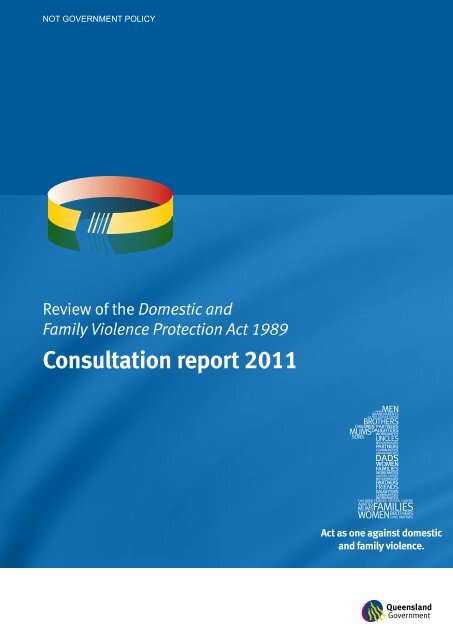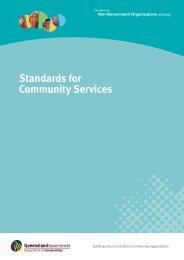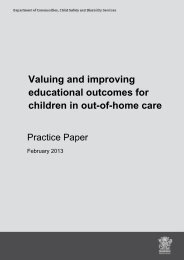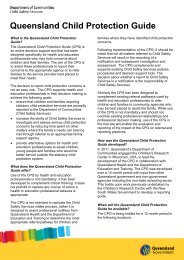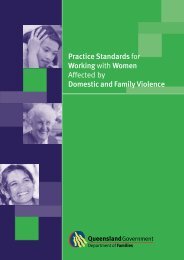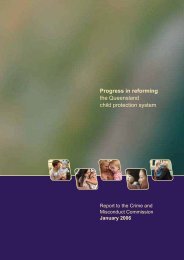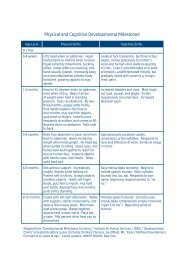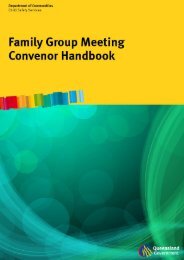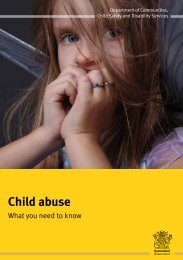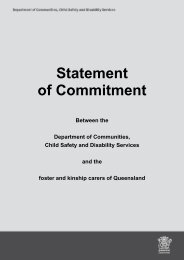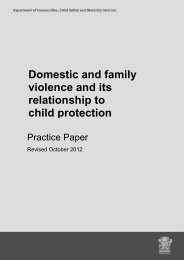Review of the Domestic and Family Violence Protection Act 1989 ...
Review of the Domestic and Family Violence Protection Act 1989 ...
Review of the Domestic and Family Violence Protection Act 1989 ...
Create successful ePaper yourself
Turn your PDF publications into a flip-book with our unique Google optimized e-Paper software.
NOT GOVERNMENT POLICY<br />
<strong>Review</strong> <strong>of</strong> <strong>the</strong> <strong>Domestic</strong> <strong>and</strong><br />
<strong>Family</strong> <strong>Violence</strong> <strong>Protection</strong> <strong>Act</strong> <strong>1989</strong><br />
Consultation report 2011<br />
<strong>Act</strong> as one against domestic<br />
<strong>and</strong> family violence.
Contents<br />
Message from <strong>the</strong> Minister.............................................................................................................................2<br />
Introduction...........................................................................................................................................................................................3<br />
How was consultation undertaken?..........................................................................................4<br />
Who made submissions?.....................................................................................................................................5<br />
Submissions from organisations...........................................................................................................5<br />
Submissions from individuals ...................................................................................................................5<br />
Regional consultation forums......................................................................................................................6<br />
Results <strong>of</strong> consultation..............................................................................................................................................7<br />
Regional differences........................................................................................................................................................8<br />
What were <strong>the</strong> responses to key issues?.....................................................................9<br />
Prevention........................................................................................................................................................................................9<br />
Definition <strong>of</strong> domestic <strong>and</strong> family violence..........................................................................9<br />
Relationships covered by <strong>the</strong> <strong>Act</strong>.....................................................................................................10<br />
Principles enshrined in <strong>the</strong> <strong>Act</strong>..............................................................................................................12<br />
Civil <strong>and</strong> criminal approaches.....................................................................................................13<br />
Balance between civil <strong>and</strong> criminal responses ......................................................13<br />
Identifying who is in need <strong>of</strong> protection — cross-applications ...15<br />
<strong>Protection</strong> <strong>of</strong> victims...........................................................................................................................................15<br />
Children <strong>and</strong> domestic <strong>and</strong> family violence...................................................................15<br />
Aboriginal <strong>and</strong> Torres Strait Isl<strong>and</strong>er people <strong>and</strong> domestic <strong>and</strong><br />
family violence....................................................................................................................................................................18<br />
Immediate police response .......................................................................................................................19<br />
Underst<strong>and</strong>ing legal processes .........................................................................................................20<br />
Perpetrator accountability....................................................................................................................22<br />
Breaches <strong>of</strong> domestic violence orders....................................................................................22<br />
Use <strong>of</strong> an ouster condition............................................................................................................................23<br />
Behaviour change programs....................................................................................................................24<br />
System planning <strong>and</strong> coordination................................................................................25<br />
Confidentiality <strong>and</strong> information sharing ...............................................................................25<br />
O<strong>the</strong>r issues......................................................................................................................................................................................27<br />
Next step...................................................................................................................................................................................................27
Message from <strong>the</strong> Minister<br />
This is <strong>the</strong> first major overhaul <strong>of</strong> Queensl<strong>and</strong>’s domestic <strong>and</strong> family<br />
violence legislation in 20 years. The suggestions for change from <strong>the</strong><br />
domestic violence sector, police, justice, health workers <strong>and</strong> o<strong>the</strong>rs<br />
dealing with this issue on <strong>the</strong> frontline, as well as individuals <strong>and</strong><br />
families directly affected, have been consistent <strong>and</strong> have provided a<br />
clear course <strong>of</strong> action for reform.<br />
Legislation dealing with domestic <strong>and</strong> family violence needs to ensure<br />
that victims are protected <strong>and</strong> that perpetrators are made accountable<br />
for <strong>the</strong>ir actions.<br />
The review <strong>of</strong> <strong>the</strong> <strong>Domestic</strong> <strong>and</strong> <strong>Family</strong> <strong>Violence</strong> <strong>Protection</strong> <strong>Act</strong> <strong>1989</strong><br />
provides an opportunity to assess <strong>the</strong> current legislation <strong>and</strong> ensure it<br />
is meeting <strong>the</strong>se objectives.<br />
I am very pleased that so many people have taken <strong>the</strong> time to<br />
contribute to <strong>the</strong> review by attending <strong>the</strong> statewide consultation<br />
forums <strong>and</strong> providing written <strong>and</strong> online submissions.<br />
In addition to your input through <strong>the</strong> forums <strong>and</strong> formal submissions,<br />
<strong>the</strong> review process will include examination <strong>of</strong> new practices <strong>and</strong><br />
developments from o<strong>the</strong>r national <strong>and</strong> international jurisdictions.<br />
This will ensure policy positions are well informed <strong>and</strong> contribute to<br />
achieving an effective response to domestic <strong>and</strong> family violence.<br />
I would like to thank all respondents who took <strong>the</strong> opportunity to have<br />
<strong>the</strong>ir say on <strong>the</strong> consultation paper. Your experience <strong>and</strong> knowledge<br />
have provided valuable insights into critical issues involving domestic<br />
<strong>and</strong> family violence <strong>and</strong> how <strong>the</strong>se issues may be better addressed.<br />
Karen Stru<strong>the</strong>rs MP<br />
Minister for Community Services <strong>and</strong> Housing<br />
<strong>and</strong> Minister for Women<br />
2
Introduction<br />
As part <strong>of</strong> <strong>the</strong> review <strong>of</strong> <strong>the</strong> <strong>Domestic</strong> <strong>and</strong> <strong>Family</strong> <strong>Violence</strong> <strong>Protection</strong> <strong>Act</strong><br />
<strong>1989</strong>, <strong>the</strong> Department <strong>of</strong> Communities undertook an extensive consultation<br />
process from March to May 2010.<br />
The terms <strong>of</strong> reference for <strong>the</strong> review were developed to facilitate analysis<br />
<strong>of</strong> a range <strong>of</strong> issues relevant to <strong>the</strong> legislation <strong>and</strong> to stakeholders’<br />
interests. The focus for <strong>the</strong> review involved:<br />
1. ensuring <strong>the</strong> legislation supports <strong>the</strong> implementation <strong>of</strong> For our Sons<br />
<strong>and</strong> Daughters: A Queensl<strong>and</strong> Government strategy to reduce domestic<br />
<strong>and</strong> family violence 2009–2014<br />
2. ensuring <strong>the</strong> legislation reflects contemporary underst<strong>and</strong>ings <strong>of</strong><br />
domestic <strong>and</strong> family violence — for example, <strong>the</strong> types <strong>of</strong> relationships<br />
<strong>and</strong> behaviours covered by <strong>the</strong> legislation<br />
3. examining existing mechanisms <strong>and</strong> alternative options to ensure <strong>the</strong><br />
legislation:<br />
• protects those who experience domestic <strong>and</strong> family violence from<br />
fur<strong>the</strong>r violence<br />
• provides for <strong>the</strong> safety <strong>and</strong> wellbeing <strong>of</strong> children <strong>and</strong> young people<br />
affected by domestic <strong>and</strong> family violence<br />
• holds those who commit domestic <strong>and</strong> family violence accountable<br />
4. examining <strong>the</strong> efficiency <strong>and</strong> effectiveness <strong>of</strong> <strong>the</strong> operation <strong>of</strong> <strong>the</strong><br />
legislation, including its intersection with o<strong>the</strong>r <strong>Act</strong>s, <strong>and</strong> determining<br />
whe<strong>the</strong>r any legislative refinements are necessary<br />
5. examining o<strong>the</strong>r matters pertaining to <strong>the</strong> efficiency <strong>and</strong> effectiveness <strong>of</strong><br />
<strong>the</strong> legislation as required by <strong>the</strong> Minister.<br />
<strong>Review</strong> <strong>of</strong> <strong>the</strong> <strong>Domestic</strong> <strong>and</strong> <strong>Family</strong> <strong>Violence</strong> <strong>Protection</strong> <strong>Act</strong> <strong>1989</strong> — Consultation report 2011 3
How was consultation undertaken?<br />
A consultation paper was developed which focused on <strong>the</strong> following<br />
areas identified as underpinning best practice in domestic violence<br />
legislation:<br />
• prevention<br />
• civil <strong>and</strong> criminal approaches<br />
• protection <strong>of</strong> victims<br />
• perpetrator accountability<br />
• system planning <strong>and</strong> coordination.<br />
These areas were identified through <strong>the</strong> development <strong>of</strong> <strong>the</strong> For our<br />
sons <strong>and</strong> daughters: A Queensl<strong>and</strong> government strategy to reduce<br />
domestic <strong>and</strong> family violence 2009–2014 <strong>and</strong> from research, input<br />
from stakeholders to <strong>the</strong> Department <strong>of</strong> Communities over recent<br />
years, <strong>and</strong> legislation <strong>and</strong> practices in o<strong>the</strong>r jurisdictions.<br />
The consultation paper was distributed via a letter from <strong>the</strong> Minister<br />
to key stakeholders <strong>and</strong> was published on <strong>the</strong> Department <strong>of</strong><br />
Communities website (www.communities.qld.gov.au) <strong>and</strong> Get<br />
Involved website (www.getinvolved.qld.gov.au).<br />
Overall, 214 submissions were received in response to <strong>the</strong><br />
consultation paper. These comprised 79 written submissions<br />
(43 from organisations, seven from government agencies <strong>and</strong> 29 from<br />
individuals) <strong>and</strong> 135 responses through <strong>the</strong> Get Involved website<br />
(four from organisations, 131 from individuals).<br />
4
Who made submissions?<br />
Submissions from organisations<br />
O<strong>the</strong>r<br />
11 12 13 14 15<br />
10<br />
9<br />
8<br />
7<br />
6<br />
5<br />
1<br />
4<br />
Women’s services<br />
2<br />
3<br />
Men’s services<br />
Women’s Services<br />
1 <strong>Domestic</strong> violence<br />
2 Housing/accommodation<br />
3 Health<br />
Men’s Services<br />
4 <strong>Domestic</strong> violence<br />
O<strong>the</strong>r<br />
5 Legal<br />
6 Child <strong>and</strong> youth<br />
7 Religious/charity affiliations<br />
8 Peak bodies<br />
9 Pr<strong>of</strong>essional bodies/associations<br />
10 Aboriginal <strong>and</strong> Torres Strait Isl<strong>and</strong>er<br />
services<br />
11 Research/academic<br />
12 Migrant services<br />
13 Culturally <strong>and</strong> Linguistically Diverse<br />
(CALD)<br />
14 Elder support services<br />
15 Disability services<br />
NGOs <strong>and</strong> o<strong>the</strong>r agencies<br />
Men<br />
Women<br />
Submissions from individuals<br />
Individuals provided <strong>the</strong> greatest number <strong>of</strong> submissions through <strong>the</strong> Get Involved<br />
web site. Of <strong>the</strong> individuals who responded, 40 did not provide any identifying<br />
information.<br />
es<br />
NGOs <strong>and</strong> o<strong>the</strong>r agencies<br />
12<br />
11<br />
10<br />
9<br />
8<br />
7<br />
6<br />
13<br />
5<br />
1<br />
4<br />
Men<br />
2<br />
Women<br />
3<br />
Women<br />
1 Victims<br />
2 Community<br />
Men<br />
3 Victims<br />
4 Community<br />
Non-government organisations<br />
(NGOs) <strong>and</strong> o<strong>the</strong>r agencies<br />
5 Legal<br />
6 Academic<br />
7 Migrant services<br />
8 CALD<br />
9 Aboriginal services<br />
10 Torres Strait Isl<strong>and</strong>er services<br />
11 Child <strong>and</strong> youth<br />
12 O<strong>the</strong>r<br />
13 No details provided<br />
<strong>Review</strong> <strong>of</strong> <strong>the</strong> <strong>Domestic</strong> <strong>and</strong> <strong>Family</strong> <strong>Violence</strong> <strong>Protection</strong> <strong>Act</strong> <strong>1989</strong> — Consultation report 2011 5
Regional consultation forums<br />
Twenty-two consultation forums were held across 17 regions in<br />
Queensl<strong>and</strong>. These forums were attended by 365 people. The<br />
statewide consultation process sought feedback on a range <strong>of</strong> issues<br />
relating to domestic violence legislation <strong>and</strong> policy. Those consulted<br />
included <strong>the</strong> Queensl<strong>and</strong> Police Service, <strong>the</strong> Department <strong>of</strong> Justice<br />
<strong>and</strong> Attorney-General, court staff, Legal Aid Queensl<strong>and</strong>, individuals,<br />
stakeholders <strong>and</strong> <strong>the</strong> community.<br />
6
Results <strong>of</strong> consultation<br />
The following are <strong>the</strong> main <strong>the</strong>mes which emerged from <strong>the</strong><br />
consultation:<br />
• Changes to <strong>the</strong> definition <strong>of</strong> domestic <strong>and</strong> family violence which<br />
acknowledge <strong>the</strong> unacceptability <strong>of</strong> domestic violence, <strong>the</strong> range<br />
<strong>of</strong> abuses it comprises, <strong>and</strong> <strong>the</strong> power <strong>and</strong> control dynamics which<br />
underpin this form <strong>of</strong> violence are desirable.<br />
• The current relationship categories are largely adequate, though<br />
some clarification is required, especially regarding ‘intimate<br />
personal relationships’.<br />
• Principles should be included in <strong>the</strong> legislation as <strong>the</strong>y would assist<br />
in achieving a consistent approach in <strong>the</strong> interpretation <strong>of</strong> <strong>the</strong> <strong>Act</strong>.<br />
• A greater criminal justice approach should exist in parallel with<br />
<strong>the</strong> civil process to enforce <strong>the</strong> message that domestic violence is<br />
unacceptable.<br />
• The impact on children who are witnesses to domestic violence<br />
needs to be reflected in <strong>the</strong> legislation.<br />
• Legislative guidance is required for victims <strong>of</strong> domestic violence<br />
who are from culturally or linguistically diverse backgrounds so that<br />
<strong>the</strong>y have fair <strong>and</strong> equal access to justice processes.<br />
• Offenders need to be made accountable for <strong>the</strong>ir actions <strong>and</strong><br />
consideration should be given to <strong>the</strong> use <strong>of</strong> behaviour change<br />
programs to reduce <strong>the</strong> severity or likelihood <strong>of</strong> domestic violence.<br />
• Short-term police-issued orders <strong>and</strong> an increase in <strong>the</strong> detention<br />
time available to police for a person taken into custody would<br />
contribute to victim safety <strong>and</strong> perpetrator accountability by<br />
demonstrating an immediate response to domestic violence.<br />
• System reforms are required particularly for training those involved<br />
in implementing <strong>the</strong> legislation <strong>and</strong> to facilitate information sharing<br />
<strong>and</strong> integrated approaches.<br />
<strong>Review</strong> <strong>of</strong> <strong>the</strong> <strong>Domestic</strong> <strong>and</strong> <strong>Family</strong> <strong>Violence</strong> <strong>Protection</strong> <strong>Act</strong> <strong>1989</strong> — Consultation report 2011 7
Regional differences<br />
A number <strong>of</strong> variations in responses were identified in <strong>the</strong> forum<br />
consultations according to <strong>the</strong> different locations around <strong>the</strong> state,<br />
including:<br />
• While <strong>the</strong>re was support for including changes to <strong>the</strong> legislation to<br />
increase <strong>the</strong> use <strong>of</strong> ouster conditions, <strong>the</strong>re was concern raised<br />
outside south-east Queensl<strong>and</strong> that ouster conditions may not be<br />
as effective in remote <strong>and</strong> regional areas.<br />
• There was increased support for <strong>the</strong> use <strong>of</strong> police issued orders in<br />
areas outside south-east Queensl<strong>and</strong> as it was felt that <strong>the</strong>y would<br />
provide an immediate response <strong>and</strong> safety for <strong>the</strong> aggrieved. This<br />
was viewed as a solution where court sittings are infrequent <strong>and</strong><br />
may involve a delay <strong>of</strong> some weeks.<br />
• Support was expressed in regional areas for increased referral to<br />
behaviour change programs. However, <strong>the</strong> availability <strong>of</strong> programs<br />
<strong>and</strong> <strong>the</strong> difficulty <strong>of</strong> respondents being able to travel to programs<br />
were raised as issues <strong>of</strong> concern.<br />
• Women in regional or remote locations experiencing domestic<br />
violence are less likely to report <strong>the</strong> violence <strong>and</strong> are more likely<br />
to remain in <strong>the</strong> relationship. This was particularly <strong>the</strong> case for<br />
Aboriginal <strong>and</strong> Torres Strait Isl<strong>and</strong>er women.<br />
8
What were <strong>the</strong> responses to key issues?<br />
The following sections summarise <strong>the</strong> results <strong>of</strong> consultation. These<br />
are organised according to <strong>the</strong> structure <strong>of</strong> <strong>the</strong> consultation paper<br />
<strong>and</strong> provide an overview <strong>of</strong> <strong>the</strong> most commonly expressed views <strong>and</strong><br />
ideas. A few quotes from submissions are provided where relevant<br />
but <strong>the</strong>y do not represent government policy or opinion.<br />
Prevention<br />
Definition <strong>of</strong> domestic <strong>and</strong> family violence<br />
How domestic <strong>and</strong> family violence is defined has implications for<br />
how this type <strong>of</strong> violence is treated by police, <strong>the</strong> courts <strong>and</strong> <strong>the</strong><br />
community.<br />
In written <strong>and</strong> online responses, 122 respondents 1 (61 per cent)<br />
indicated that <strong>the</strong> current definition <strong>of</strong> domestic <strong>and</strong> family violence is<br />
inadequate <strong>and</strong> should include additional forms <strong>of</strong> abuse.<br />
There are many forms <strong>of</strong> abuse <strong>and</strong> different ways in which it<br />
shows <strong>and</strong> is expressed. The wider <strong>the</strong> definition, <strong>the</strong> better we<br />
are able to underst<strong>and</strong> <strong>the</strong> different meanings <strong>of</strong> abuse. The<br />
tension between flexibility <strong>and</strong> clarity is at issue here.<br />
Participants at 21 <strong>of</strong> <strong>the</strong> statewide consultation sessions expressed<br />
<strong>the</strong> view that <strong>the</strong> current definition needs to be broadened to<br />
include all forms <strong>of</strong> abuse <strong>and</strong> <strong>the</strong>re needs to be more clarity in <strong>the</strong><br />
definitions.<br />
The Victorian legislation was cited as a good example for dealing<br />
with this aspect <strong>of</strong> <strong>the</strong> legislation. It was considered that <strong>the</strong> definition<br />
should be more comprehensive <strong>and</strong> draw on s5(1) <strong>of</strong> <strong>the</strong> Victorian<br />
<strong>Family</strong> <strong>Violence</strong> <strong>Protection</strong> <strong>Act</strong> 2008 which covers physical, sexual,<br />
emotional, psychological, economic, threatening <strong>and</strong> coercive<br />
behaviours, including naming exposure to children as a form <strong>of</strong><br />
abuse.<br />
There was support (59 responses) for <strong>the</strong> inclusion <strong>of</strong> emotional<br />
abuse <strong>and</strong> financial abuse in <strong>the</strong> definition <strong>of</strong> behaviours, though <strong>the</strong><br />
difficulty with obtaining evidence for <strong>the</strong>se types <strong>of</strong> abuse was noted.<br />
In 21 <strong>of</strong> <strong>the</strong> 22 statewide consultations, <strong>the</strong>re was support for <strong>the</strong><br />
inclusion <strong>of</strong> emotional <strong>and</strong> economic abuse, though some concern<br />
was expressed about <strong>the</strong> impact <strong>of</strong> net widening on resources.<br />
However, it was largely considered that more clarity in <strong>the</strong> legislation<br />
would lead to greater consistency in decision-making <strong>and</strong> would be<br />
helpful for those involved, including police.<br />
1 ‘Respondent’ is used in this report to refer to those who contributed to <strong>the</strong> review through<br />
a written submission or a response through <strong>the</strong> Get Involved website. Perpetrators <strong>of</strong><br />
domestic violence are usually referred to as ‘<strong>of</strong>fenders’ to avoid confusion.<br />
<strong>Review</strong> <strong>of</strong> <strong>the</strong> <strong>Domestic</strong> <strong>and</strong> <strong>Family</strong> <strong>Violence</strong> <strong>Protection</strong> <strong>Act</strong> <strong>1989</strong> — Consultation report 2011 9
Nineteen respondents indicated that <strong>the</strong> legislation should<br />
acknowledge <strong>the</strong> power <strong>and</strong> control dynamics <strong>of</strong> domestic violence<br />
which is based on exploitation <strong>of</strong> power imbalances. Fourteen<br />
<strong>of</strong> <strong>the</strong>se indicated that fear, intimidation <strong>and</strong> threats need to<br />
be acknowledged in <strong>the</strong> definition <strong>of</strong> domestic violence. Seven<br />
respondents specified that electronic means <strong>of</strong> harassment should be<br />
included in <strong>the</strong> definition.<br />
A fur<strong>the</strong>r seven respondents indicated that <strong>the</strong> legislation should<br />
reflect <strong>the</strong> gendered nature <strong>of</strong> domestic violence. Three <strong>of</strong> <strong>the</strong>se took<br />
<strong>the</strong> view that this could be captured in <strong>the</strong> legislation by separating<br />
out violence involving intimate partners <strong>and</strong> violence involving o<strong>the</strong>r<br />
domestic relationships.<br />
Sixty-four respondents indicated that sexual abuse should be<br />
specifically included in <strong>the</strong> definition <strong>of</strong> domestic violence. Any<br />
reference to sexual violence should provide a broader context<br />
to intimate violence, though it should not be considered that<br />
civil protection orders are <strong>the</strong> best or only way to address such<br />
behaviours.<br />
Relationships covered by <strong>the</strong> <strong>Act</strong><br />
The current legislation defines domestic relationships as spousal<br />
relationships, intimate personal relationships, family relationships,<br />
<strong>and</strong> informal care relationships. How domestic relationships are<br />
defined <strong>and</strong> interpreted by police, <strong>the</strong> courts <strong>and</strong> <strong>the</strong> community has<br />
implications for how acts <strong>of</strong> violence are dealt with <strong>and</strong> <strong>the</strong>refore<br />
whe<strong>the</strong>r <strong>the</strong> mechanisms in <strong>the</strong> <strong>Domestic</strong> <strong>and</strong> <strong>Family</strong> <strong>Violence</strong><br />
<strong>Protection</strong> <strong>Act</strong> <strong>1989</strong> can be applied.<br />
Comments made by respondents indicated support for <strong>the</strong><br />
relationship categories in <strong>the</strong> current legislation. However, 72<br />
respondents (36 per cent) suggested that <strong>the</strong>re needs to be some<br />
fine-tuning <strong>of</strong> <strong>the</strong>se categories. While <strong>the</strong> current relationship<br />
categories were supported in 18 <strong>of</strong> <strong>the</strong> statewide consultation<br />
sessions, in 13 <strong>of</strong> <strong>the</strong>se sessions <strong>the</strong> following changes were also<br />
proposed:<br />
• in-laws should be included, as well as ex-partners’ new partners<br />
<strong>and</strong> <strong>the</strong>ir families<br />
• any person who is regarded as being like a family member<br />
should be included, such as a child who normally resides with <strong>the</strong><br />
victim.<br />
As noted in <strong>the</strong> previous section, three respondents advocated<br />
for a reduction in <strong>the</strong> categories <strong>of</strong> relationships currently covered<br />
in <strong>the</strong> <strong>Domestic</strong> <strong>and</strong> <strong>Family</strong> <strong>Violence</strong> <strong>Protection</strong> <strong>Act</strong> <strong>1989</strong> <strong>and</strong> for<br />
differentiating between domestic <strong>and</strong> non-domestic violence, ei<strong>the</strong>r<br />
within <strong>the</strong> <strong>Act</strong> or through different pieces <strong>of</strong> legislation.<br />
10
Seventeen respondents indicated that <strong>the</strong> concept <strong>of</strong> ‘intimate<br />
personal relationships’ needed to be clarified <strong>and</strong> <strong>the</strong> wording<br />
‘enmeshed’, used in <strong>the</strong> current legislation, should be removed. This<br />
is because <strong>of</strong> <strong>the</strong> ambiguity associated with <strong>the</strong> term <strong>and</strong> because<br />
it is difficult to prove. It was also suggested in 10 <strong>of</strong> <strong>the</strong> statewide<br />
consultation sessions that <strong>the</strong> definition <strong>of</strong> ‘intimate personal<br />
relationships’ requires clarification.<br />
The category <strong>of</strong> ’intimate personal relationship’ <strong>and</strong> <strong>the</strong> term<br />
’enmeshment’ as covered under <strong>the</strong> <strong>Domestic</strong> <strong>and</strong> <strong>Family</strong><br />
<strong>Violence</strong> <strong>Protection</strong> <strong>Act</strong> <strong>1989</strong> provide a number <strong>of</strong> interpretation<br />
challenges…an intimate personal relationship can exist without<br />
’enmeshment’ <strong>and</strong> whe<strong>the</strong>r or not <strong>the</strong> relationship involves a<br />
sexual relationship.<br />
It was also suggested in ten <strong>of</strong> <strong>the</strong> statewide consultation sessions<br />
that <strong>the</strong> definition <strong>of</strong> ‘intimate personal relationships’ requires<br />
clarification. Some stakeholders called for <strong>the</strong> definition to include<br />
people in dating relationships, while o<strong>the</strong>rs were reluctant for<br />
any fur<strong>the</strong>r broadening <strong>of</strong> relationships covered by <strong>the</strong> <strong>Act</strong> due<br />
to concerns that <strong>the</strong> intention <strong>of</strong> <strong>the</strong> legislation would be lost.<br />
However, <strong>the</strong>re was little support for separating domestic <strong>and</strong> family<br />
relationships, though <strong>the</strong> Townsville session was <strong>of</strong> <strong>the</strong> view that <strong>the</strong><br />
legislation is for <strong>the</strong> protection <strong>of</strong> people with an emotional connection<br />
<strong>and</strong> who are reluctant to use <strong>the</strong> criminal justice system.<br />
Among <strong>the</strong> written responses <strong>of</strong> those commenting on this issue<br />
<strong>the</strong>re were differing opinions regarding whe<strong>the</strong>r short-term or casual<br />
dating relationships should be included in <strong>the</strong> definition <strong>of</strong> domestic<br />
relationships.<br />
Those who supported <strong>the</strong> inclusion <strong>of</strong> all dating relationships cited <strong>the</strong><br />
broader underst<strong>and</strong>ing <strong>of</strong> contemporary relationships, including older<br />
people who form relationships for companionship but wish to retain<br />
<strong>the</strong>ir independence. In addition, with <strong>the</strong> emergence <strong>of</strong> technology,<br />
<strong>the</strong> affordability <strong>of</strong> travel, <strong>and</strong> changes to banking habits, people are<br />
conducting relationships differently <strong>and</strong> this has implications for <strong>the</strong><br />
concept <strong>of</strong> intimate personal relationships.<br />
Those who considered that short-term or casual dating relationships<br />
should not be included noted <strong>the</strong> intent <strong>of</strong> <strong>the</strong> legislation in covering<br />
intimate personal relationships where <strong>the</strong>re is reliance <strong>and</strong>/or<br />
dependency for emotional <strong>and</strong> physical security or wellbeing. Two<br />
submissions <strong>and</strong> one statewide consultation session considered<br />
that internet dating should also be included since <strong>the</strong> abuser has <strong>the</strong><br />
power to use personal information electronically to harass <strong>the</strong> victim.<br />
Ten respondents commented on <strong>the</strong> issue <strong>of</strong> whe<strong>the</strong>r formal carers<br />
should be included in <strong>the</strong> definition <strong>of</strong> domestic relationships. Of<br />
<strong>the</strong>se, most supported <strong>the</strong> inclusion <strong>of</strong> formal carers in domestic<br />
relationships, however, <strong>the</strong> higher level <strong>of</strong> vulnerability <strong>of</strong> people who<br />
require care was also noted, raising questions about whe<strong>the</strong>r orders<br />
are a suitable response in <strong>the</strong>se cases.<br />
<strong>Review</strong> <strong>of</strong> <strong>the</strong> <strong>Domestic</strong> <strong>and</strong> <strong>Family</strong> <strong>Violence</strong> <strong>Protection</strong> <strong>Act</strong> <strong>1989</strong> — Consultation report 2011 11
In one statewide consultation session, <strong>the</strong> view was expressed<br />
that formal carers should be included in <strong>the</strong> legislation to prevent<br />
fraud <strong>and</strong> institutional abuse, while ano<strong>the</strong>r session stressed <strong>the</strong><br />
importance <strong>of</strong> maintaining <strong>the</strong> domiciled nature <strong>of</strong> relationships.<br />
Principles enshrined in <strong>the</strong> <strong>Act</strong><br />
The current legislation does not include principles, however <strong>the</strong><br />
purpose sets out <strong>the</strong> intent <strong>of</strong> <strong>the</strong> legislation. This intent is to provide<br />
for <strong>the</strong> safety <strong>and</strong> protection <strong>of</strong> a person, if a defined domestic<br />
relationship exists, by allowing <strong>the</strong> court to make a domestic violence<br />
order.<br />
Of <strong>the</strong> 158 responses that commented on <strong>the</strong> issue <strong>of</strong> whe<strong>the</strong>r<br />
principles should be included in <strong>the</strong> legislation 85 (54 per cent)<br />
pointed out <strong>the</strong> benefits <strong>of</strong> including principles, in particular:<br />
• sending a message to <strong>the</strong> community that domestic violence is<br />
unacceptable<br />
• providing guidance to those using <strong>the</strong> legislation.<br />
Support for <strong>the</strong> inclusion <strong>of</strong> principles was expressed in 20 <strong>of</strong> <strong>the</strong><br />
statewide consultation sessions.<br />
The New South Wales legislation was mentioned in <strong>the</strong> context <strong>of</strong><br />
guiding principles by 15 respondents <strong>and</strong> three referred to elements<br />
<strong>of</strong> <strong>the</strong> preamble in <strong>the</strong> Victorian legislation. These reflect <strong>the</strong><br />
promotion <strong>of</strong> non-violence, <strong>the</strong> unacceptability <strong>of</strong> family violence, <strong>the</strong><br />
gendered nature <strong>of</strong> domestic violence, <strong>the</strong> emphasis on <strong>the</strong> level<br />
<strong>of</strong> fear <strong>and</strong> who is in need <strong>of</strong> protection. The principles in <strong>the</strong> Child<br />
<strong>Protection</strong> <strong>Act</strong> 1999 were also cited as a good example:<br />
As both <strong>of</strong> <strong>the</strong>se pieces <strong>of</strong> legislation deal with complex social<br />
issues, guiding principles are an ideal place to set out <strong>the</strong><br />
rights <strong>and</strong> responsibilities <strong>of</strong> those affected by matters dealt<br />
with in <strong>the</strong> <strong>Act</strong>, <strong>the</strong> intention <strong>of</strong> <strong>the</strong> <strong>Act</strong>, <strong>the</strong> context <strong>of</strong> <strong>the</strong><br />
powers <strong>of</strong> those who enact <strong>the</strong> <strong>Act</strong>.<br />
The following were some areas cited for inclusion in <strong>the</strong> principles:<br />
• <strong>the</strong> unacceptability <strong>of</strong> domestic violence<br />
• domestic violence as a violation <strong>of</strong> human rights<br />
• <strong>the</strong> gendered nature <strong>of</strong> domestic violence <strong>and</strong> <strong>the</strong> use <strong>of</strong> power<br />
<strong>and</strong> control<br />
• <strong>the</strong> need to prevent <strong>and</strong> reduce violence<br />
• protecting <strong>the</strong> aggrieved<br />
• protecting children who are exposed to domestic violence<br />
• treating victims at all times with dignity, respect, courtesy <strong>and</strong><br />
underst<strong>and</strong>ing.<br />
Fifty-three respondents commented on who should be guided by<br />
principles. In general, <strong>the</strong> view was that principles should serve a<br />
dual purpose <strong>of</strong> sending a message to <strong>the</strong> community about domestic<br />
12
violence as well as providing guidance to those using <strong>the</strong> legislation<br />
including magistrates, registrars, judges, court staff, women’s<br />
domestic violence services, <strong>and</strong> family support services.<br />
Respondents who did not think principles should be included (23)<br />
considered that this reduced <strong>the</strong> workability <strong>of</strong> <strong>the</strong> legislation <strong>and</strong><br />
allowed for s<strong>of</strong>t options, or did not make any ‘real world’ difference to<br />
how <strong>the</strong> <strong>Act</strong> functioned.<br />
Civil <strong>and</strong> criminal approaches<br />
Balance between civil <strong>and</strong> criminal responses<br />
In Queensl<strong>and</strong>, <strong>the</strong> legal response to domestic violence relies on a<br />
combination <strong>of</strong> civil domestic violence orders <strong>and</strong> criminal sanctions.<br />
Failure to comply with <strong>the</strong> terms <strong>of</strong> a domestic violence order is a<br />
breach which is a criminal <strong>of</strong>fence <strong>and</strong> is dealt with in <strong>the</strong> criminal<br />
jurisdiction <strong>of</strong> <strong>the</strong> courts.<br />
A majority <strong>of</strong> respondents (104) (71 per cent) agreed <strong>the</strong>re needed to<br />
be a change in <strong>the</strong> balance between <strong>the</strong> civil <strong>and</strong> criminal responses<br />
to domestic violence. While <strong>the</strong> value <strong>of</strong> <strong>the</strong> civil process was<br />
acknowledged (especially regarding its accessibility <strong>and</strong> <strong>the</strong> lower<br />
burden <strong>of</strong> pro<strong>of</strong> required), it was generally accepted that <strong>the</strong> criminal<br />
process should exist in parallel with <strong>the</strong> civil process.<br />
In 13 <strong>of</strong> <strong>the</strong> statewide consultation sessions, <strong>the</strong>re was support for<br />
a mixture <strong>of</strong> civil <strong>and</strong> criminal responses. However, in 10 sessions<br />
participants indicated support for a stronger criminal justice approach.<br />
Reasons given in support <strong>of</strong> an increased criminal justice approach<br />
included:<br />
• <strong>the</strong> need to enforce a zero tolerance message <strong>and</strong> ensure<br />
accountability <strong>of</strong> perpetrators<br />
• recognition that assault within <strong>the</strong> home is a crime <strong>and</strong> should not<br />
be treated differently from any o<strong>the</strong>r assault<br />
• a perception that <strong>the</strong> current approach is ineffective. A view that<br />
breaches <strong>of</strong> orders are not adequately enforced or <strong>the</strong> resulting<br />
penalties are inadequate.<br />
The suggested means for achieving an increased criminal justice<br />
focus were varied. Suggestions included:<br />
• an amendment to section 67 which currently places obligations<br />
on police in investigating suspected domestic violence incidents<br />
to require <strong>the</strong>m to consider obtaining evidence <strong>and</strong> charging a<br />
substantive criminal <strong>of</strong>fence, in addition to applying for a domestic<br />
violence order, if sufficient evidence exists<br />
• an increased focus on police investigation techniques to ensure<br />
less reliance is placed on <strong>the</strong> victim’s statement <strong>and</strong> evidence is<br />
procured from o<strong>the</strong>r sources, such as o<strong>the</strong>r witness statements,<br />
medical evidence, or photographs <strong>of</strong> injuries<br />
<strong>Review</strong> <strong>of</strong> <strong>the</strong> <strong>Domestic</strong> <strong>and</strong> <strong>Family</strong> <strong>Violence</strong> <strong>Protection</strong> <strong>Act</strong> <strong>1989</strong> — Consultation report 2011 13
• using <strong>the</strong> current range <strong>of</strong> <strong>of</strong>fences under <strong>the</strong> Criminal Code,<br />
but recognising <strong>the</strong> commission <strong>of</strong> <strong>the</strong>se <strong>of</strong>fences in a domestic<br />
context as a circumstance <strong>of</strong> aggravation, given <strong>the</strong> betrayal <strong>of</strong><br />
trust that results when a person commits acts <strong>of</strong> violence against<br />
a spouse or o<strong>the</strong>r family member.<br />
Twenty-six respondents were supportive <strong>of</strong> <strong>the</strong> development <strong>of</strong> a<br />
pro-arrest approach where criminal charges are laid regardless <strong>of</strong> <strong>the</strong><br />
wishes <strong>of</strong> <strong>the</strong> victim. Eighteen respondents suggested that police<br />
should ga<strong>the</strong>r enough evidence (a ‘pro-investigation’ approach) to<br />
reduce <strong>the</strong> pressure on <strong>the</strong> victim. Processes would also be required<br />
to address <strong>the</strong> elevated risk to <strong>the</strong> victim after an <strong>of</strong>fender is charged<br />
<strong>and</strong> to reduce <strong>the</strong> trauma associated with giving evidence.<br />
...a pro-investigation approach [should] be implemented<br />
to ensure that current criminal responses are applied<br />
appropriately, for example: assault, stalking, arson, grievous<br />
bodily harm, deprivation <strong>of</strong> liberty.<br />
There were 80 responses supporting <strong>the</strong> creation <strong>of</strong> a separate,<br />
st<strong>and</strong>-alone <strong>of</strong>fence <strong>of</strong> committing domestic violence <strong>and</strong> 35<br />
responses indicated that such an <strong>of</strong>fence is not necessary. At four<br />
statewide consultation sessions <strong>the</strong>re was support for <strong>the</strong> creation <strong>of</strong><br />
a separate, st<strong>and</strong>-alone <strong>of</strong>fence <strong>and</strong> at eight, views were expressed<br />
against creating a separate <strong>of</strong>fence. Many stakeholders in <strong>the</strong>se<br />
sessions indicated that <strong>the</strong> current range <strong>of</strong> <strong>of</strong>fences is sufficient to<br />
address behaviours which can constitute domestic violence. It was<br />
suggested, however, that <strong>the</strong>re is a need to improve processes so<br />
that police more readily charge <strong>and</strong> prosecute criminal <strong>of</strong>fences.<br />
Those against <strong>the</strong> creation <strong>of</strong> a separate <strong>of</strong>fence indicated that this<br />
was because <strong>the</strong>re are already a number <strong>of</strong> <strong>of</strong>fences within <strong>the</strong><br />
Criminal Code which cover behaviours that can constitute an act <strong>of</strong><br />
domestic violence. It was also suggested that a separate domestic<br />
violence <strong>of</strong>fence may reinforce <strong>the</strong> notion that <strong>of</strong>fences occurring<br />
within a domestic context are less serious than o<strong>the</strong>r criminal<br />
<strong>of</strong>fences.<br />
...we argue that, if <strong>the</strong> <strong>of</strong>fence <strong>of</strong> committing domestic violence<br />
is created, this definition may mitigate its severity. M<strong>and</strong>atory<br />
police prosecution <strong>of</strong> <strong>of</strong>fenders under <strong>the</strong> relevant section <strong>of</strong> <strong>the</strong><br />
Queensl<strong>and</strong> Criminal Code such as assault, causing grievous<br />
bodily harm, or assault occasioning bodily harm would serve as<br />
a greater disincentive to commit an act <strong>of</strong> domestic violence.<br />
Those who supported a separate <strong>of</strong>fence <strong>of</strong> committing domestic<br />
violence noted that this could cover behaviours which are not<br />
adequately addressed in <strong>the</strong> current Criminal Code <strong>and</strong> could also<br />
complement <strong>the</strong> civil domestic violence order. It would help to enforce<br />
a zero tolerance message by establishing that domestic violence is a<br />
crime.<br />
There were 49 responses indicating that breaches needed to be<br />
enforced more consistently, especially breaches involving non-<br />
14
physical violence. In addition, <strong>the</strong>re needs to be consistency among<br />
magistrates in imposing appropriate penalties.<br />
Those who indicated that <strong>the</strong> existing range <strong>of</strong> <strong>of</strong>fences was not<br />
adequate suggested additional <strong>of</strong>fences such as damage to a<br />
person’s livelihood, sexual deviation, psychological abuse <strong>and</strong><br />
manipulation. Seven respondents considered that attempted<br />
strangulation should be included as this is a known precursor to<br />
domestic homicide.<br />
Identifying who is in need <strong>of</strong> protection —<br />
cross-applications<br />
The current Queensl<strong>and</strong> legislation does not contain guidelines for<br />
who is most at risk <strong>and</strong> in need <strong>of</strong> protection in a domestic violence<br />
incident. The result can be that it may be difficult to ascertain <strong>the</strong><br />
party who is <strong>the</strong> real perpetrator <strong>of</strong> <strong>the</strong> violence in <strong>the</strong> relationship<br />
when police attend an incident.<br />
There was support for <strong>the</strong> development <strong>of</strong> responses aimed at<br />
identifying who most needs protection <strong>and</strong> recognition <strong>of</strong> <strong>the</strong><br />
importance <strong>of</strong> identifying <strong>the</strong> predominant aggressor to address <strong>the</strong><br />
issue <strong>of</strong> cross-applications. Of <strong>the</strong> 122 responses to this issue, 100<br />
(82 per cent) indicated that <strong>the</strong> legislation should be amended to<br />
enable this identification. This was also <strong>the</strong> view in 14 <strong>of</strong> <strong>the</strong> statewide<br />
consultation sessions. A number <strong>of</strong> contributors considered that <strong>the</strong><br />
term ‘predominant aggressor’ is preferable to ‘primary aggressor’ as<br />
<strong>the</strong> latter is incident-focussed whereas <strong>the</strong> former expression takes<br />
into account <strong>the</strong> history <strong>and</strong> dynamics <strong>of</strong> <strong>the</strong> relationship.<br />
While <strong>the</strong>re was recognition <strong>of</strong> <strong>the</strong> importance <strong>of</strong> identifying <strong>the</strong><br />
main aggressor to address <strong>the</strong> issue <strong>of</strong> cross-applications, views<br />
were mixed about whe<strong>the</strong>r this should be addressed in legislation or<br />
by revising police policy <strong>and</strong> training. It was pointed out that police<br />
<strong>of</strong>ficers need to be able to determine who has <strong>the</strong> most potential for<br />
doing <strong>the</strong> most harm <strong>and</strong> whe<strong>the</strong>r actions were done in self-defence.<br />
It was also considered that police need to ensure <strong>the</strong>re is appropriate<br />
investigation <strong>of</strong> domestic violence incidents <strong>and</strong> that this investigation<br />
should be guided by <strong>the</strong> framework established for identifying <strong>the</strong><br />
person most in need <strong>of</strong> protection.<br />
<strong>Protection</strong> <strong>of</strong> victims<br />
Children <strong>and</strong> domestic <strong>and</strong> family violence<br />
Australian statistics 2 reveal that a large number <strong>of</strong> people who<br />
2 Personal Safety Survey, Australia, 2005. Australian Bureau <strong>of</strong> Statistics (2006).<br />
<strong>Review</strong> <strong>of</strong> <strong>the</strong> <strong>Domestic</strong> <strong>and</strong> <strong>Family</strong> <strong>Violence</strong> <strong>Protection</strong> <strong>Act</strong> <strong>1989</strong> — Consultation report 2011 15
experienced violence from a current or previous partner had children<br />
in <strong>the</strong>ir care during <strong>the</strong> relationship. In addition, <strong>the</strong>re is some<br />
evidence that <strong>the</strong>re are negative effects on children as a result <strong>of</strong><br />
this violence. However, <strong>the</strong> current Queensl<strong>and</strong> legislation does not<br />
specifically provide for <strong>the</strong> protection <strong>of</strong> children in this context.<br />
At 13 <strong>of</strong> <strong>the</strong> statewide consultation sessions, stakeholders suggested<br />
that <strong>the</strong> legislation should include <strong>the</strong> protection <strong>of</strong> children in its<br />
principles. Of <strong>the</strong> 134 written responses on this issue, 109 (81 per<br />
cent) suggested that <strong>the</strong> legislation should specifically include <strong>the</strong><br />
protection <strong>of</strong> children in its purpose.<br />
However, 19 (14 per cent) respondents did not believe <strong>the</strong>re needed<br />
to be changes to <strong>the</strong> legislation in this area:<br />
There are adequate laws already in place to protect children<br />
<strong>and</strong> <strong>the</strong>se laws should be fully utilised before resorting to<br />
changing <strong>the</strong> <strong>Act</strong>... such as child safety <strong>and</strong> juvenile justice<br />
legislation. It is important that incidents such as bullying are not<br />
captured under <strong>the</strong> <strong>Act</strong>.<br />
Careful consideration needs to be given to <strong>the</strong> intersection<br />
between <strong>the</strong> <strong>Family</strong> Law <strong>Act</strong> <strong>and</strong> <strong>the</strong> <strong>Domestic</strong> <strong>and</strong> <strong>Family</strong><br />
<strong>Violence</strong> <strong>Protection</strong> <strong>Act</strong> to ensure <strong>the</strong>re are no unintended<br />
consequences. It may be wise to await <strong>the</strong> outcomes <strong>of</strong> <strong>the</strong><br />
Australian Law Reform Commission inquiry into <strong>the</strong> <strong>Family</strong> Law<br />
<strong>Act</strong> before making any decisions on changes to <strong>the</strong> <strong>Act</strong>.<br />
Expressions <strong>of</strong> caution were raised regarding <strong>the</strong> inclusion <strong>of</strong> children<br />
related to ensuring <strong>the</strong> correct perpetrator is identified, domestic<br />
violence orders being used as quasi <strong>Family</strong> Law orders <strong>and</strong> <strong>the</strong><br />
potential for orders to be used to prevent contact.<br />
Ninety-nine respondents (77 per cent) supported amending <strong>the</strong><br />
definition <strong>of</strong> domestic violence to include situations where children<br />
witness or are exposed to domestic violence. However, it was pointed<br />
out that including children in <strong>the</strong> definition may draw <strong>the</strong>m into <strong>the</strong><br />
court system <strong>and</strong> also place a focus on children being harmed as<br />
a result <strong>of</strong> a parent being unable to protect <strong>the</strong>m. This could lead<br />
to reluctance to report violence due to concerns about possible<br />
interventions from Child Safety Services.<br />
A total <strong>of</strong> 45 respondents expressed support for children exposed<br />
to domestic violence being named on orders. It was suggested that<br />
<strong>the</strong>re is currently an inconsistency between <strong>the</strong> domestic violence<br />
legislation <strong>and</strong> <strong>the</strong> child protection legislation. The definition <strong>of</strong> ‘harm’<br />
in <strong>the</strong> child protection legislation is broad enough to capture exposing<br />
children to domestic violence as a form <strong>of</strong> abuse.<br />
While nine respondents expressed <strong>the</strong> view that children exposed<br />
to domestic violence should be automatically named on orders, six<br />
o<strong>the</strong>rs suggested <strong>the</strong> legislation should contain stronger directions to<br />
<strong>the</strong> court about when children should be named on orders, but this<br />
should not be automatic. In one statewide consultation session, it<br />
16
was stated that <strong>the</strong> test for naming children on orders could include<br />
whe<strong>the</strong>r <strong>the</strong>y had witnessed or been exposed to domestic violence.<br />
In a number <strong>of</strong> sessions it was recognised that witnessing domestic<br />
violence causes harm to a child but some saw this more in <strong>the</strong> realm<br />
<strong>of</strong> child protection. Some sessions noted that it is currently difficult to<br />
have children named on orders.<br />
There was no clear consensus ei<strong>the</strong>r in written submissions or in <strong>the</strong><br />
consultation forums on <strong>the</strong> issue <strong>of</strong> children being able to apply for a<br />
domestic violence order against a family member. Of <strong>the</strong> 121 written<br />
responses on this issue, 74 considered that children, or adults on<br />
behalf <strong>of</strong> children, should be able to apply for a domestic violence<br />
order against family members. The Victorian legislation was cited,<br />
noting that an application for a domestic violence order can be made<br />
by a child over 14 years with leave <strong>of</strong> a parent or leave <strong>of</strong> <strong>the</strong> court.<br />
A total <strong>of</strong> 39 respondents opposed allowing children to apply for<br />
orders in <strong>the</strong> context <strong>of</strong> violence in a family relationship noting:<br />
• <strong>the</strong> potential for manipulation by one parent who uses a child to<br />
take out an order against <strong>the</strong> o<strong>the</strong>r parent<br />
• a risk that children may take out frivolous or vexatious applications<br />
against a parent to ‘get back at’ or punish that parent<br />
• confusion between acts which constitute discipline <strong>and</strong> acts <strong>of</strong><br />
domestic violence<br />
• issues around determining a child’s capacity to make an<br />
application <strong>and</strong> participate in proceedings, <strong>and</strong> <strong>the</strong> provision <strong>of</strong><br />
legal advice <strong>and</strong> representation to child applicants<br />
• <strong>the</strong> application <strong>of</strong> <strong>the</strong> Child <strong>Protection</strong> <strong>Act</strong> 1999 to <strong>the</strong>se situations<br />
— it was noted that <strong>the</strong> <strong>Domestic</strong> <strong>and</strong> <strong>Family</strong> <strong>Violence</strong> <strong>Protection</strong><br />
<strong>Act</strong> <strong>1989</strong> is not geared to provide <strong>the</strong> requisite intensive family<br />
interventions, follow-up support, review <strong>and</strong> supervision. Instead, it<br />
relies on administration by police, potentially exposing children <strong>and</strong><br />
<strong>the</strong>ir family to criminality.<br />
In <strong>the</strong> statewide consultation forums, <strong>the</strong>re were mixed views<br />
regarding <strong>the</strong> inclusion <strong>of</strong> children as <strong>the</strong> aggrieved <strong>and</strong> respondent/<br />
<strong>of</strong>fender where family relationships exist. At almost half <strong>of</strong> <strong>the</strong><br />
sessions, <strong>the</strong>re was support for children, or adults on behalf <strong>of</strong><br />
children, to apply for a domestic violence order against a family<br />
member. Of <strong>the</strong>se it was acknowledged that age restrictions <strong>and</strong><br />
processes to provide support would be required. Responses were<br />
mixed at o<strong>the</strong>r sessions <strong>and</strong> <strong>the</strong>re were also sessions where a clear<br />
response against enabling children to make applications against<br />
family members was evident.<br />
One hundred respondents addressed <strong>the</strong> issue <strong>of</strong> whe<strong>the</strong>r children<br />
should be able to be named as respondents in <strong>the</strong> context <strong>of</strong> violence<br />
in family relationships. Of <strong>the</strong>se, 71 considered that <strong>the</strong> legislation<br />
should enable domestic violence orders to be taken out against<br />
children in a family relationship with <strong>the</strong> aggrieved. However, this<br />
support was guarded <strong>and</strong> sometimes subject to <strong>the</strong> proviso that<br />
<strong>Review</strong> <strong>of</strong> <strong>the</strong> <strong>Domestic</strong> <strong>and</strong> <strong>Family</strong> <strong>Violence</strong> <strong>Protection</strong> <strong>Act</strong> <strong>1989</strong> — Consultation report 2011 17
any criminal justice responses for breaches should be confined to<br />
restorative justice approaches or <strong>the</strong>rapeutic interventions such as<br />
counselling.<br />
At almost half <strong>the</strong> statewide consultation sessions, <strong>the</strong>re was support<br />
for family members to be able to name a child as a respondent<br />
to a domestic violence order. Those who opposed orders being<br />
taken out against children in family relationships (32 respondents)<br />
raised issues around ensuring that children underst<strong>and</strong> orders <strong>and</strong><br />
<strong>the</strong> consequences <strong>of</strong> breaching orders, including <strong>the</strong> potential for<br />
increased involvement <strong>of</strong> children in <strong>the</strong> criminal justice system <strong>and</strong><br />
increased homelessness.<br />
There were 39 respondents who considered that changes were<br />
desirable to <strong>the</strong> way consent orders are made so that <strong>the</strong> <strong>of</strong>fender<br />
underst<strong>and</strong>s <strong>the</strong> conditions <strong>and</strong> consequences <strong>of</strong> <strong>the</strong> order. The<br />
following concerns were expressed regarding consent orders: <strong>the</strong><br />
effect <strong>of</strong> devaluing <strong>the</strong> order; <strong>the</strong> lack <strong>of</strong> accountability <strong>of</strong> perpetrators;<br />
implications for <strong>the</strong> safety <strong>of</strong> women <strong>and</strong> children; <strong>and</strong> <strong>the</strong> resulting<br />
weakened response to domestic violence in <strong>the</strong> <strong>Family</strong> Law Court.<br />
Aboriginal <strong>and</strong> Torres Strait Isl<strong>and</strong>er people <strong>and</strong><br />
domestic <strong>and</strong> family violence<br />
The current domestic violence legislation in Queensl<strong>and</strong> does not<br />
make specific reference to additional requirements or issues that<br />
may apply to domestic violence involving Aboriginal <strong>and</strong> Torres Strait<br />
Isl<strong>and</strong>er people, especially in communities.<br />
There were 31 respondents that considered <strong>the</strong> current domestic<br />
relationship definition clearly includes <strong>the</strong> wider concept <strong>of</strong> family<br />
which is relevant to Aboriginal <strong>and</strong> Torres Strait Isl<strong>and</strong>er communities,<br />
while 30 o<strong>the</strong>rs believed <strong>the</strong> definition needed to provide more detail<br />
(for example, a reference to kinship principles) <strong>and</strong> recognise cultural<br />
family structures <strong>and</strong> responsibilities. Six respondents considered <strong>the</strong><br />
current legislation <strong>of</strong>fered insufficient protection to children <strong>and</strong> young<br />
people <strong>and</strong> did not adequately represent complex family or intimate<br />
relationships that exist within Aboriginal <strong>and</strong> Torres Strait Isl<strong>and</strong>er<br />
communities.<br />
One Aboriginal <strong>and</strong> Torres Strait Isl<strong>and</strong>er organisation considered<br />
that payback was a big issue for victims <strong>of</strong> domestic violence in<br />
communities. Victims are <strong>of</strong>ten fur<strong>the</strong>r abused by family or associates<br />
<strong>of</strong> <strong>the</strong> perpetrator as a result <strong>of</strong> customs <strong>and</strong> it was recommended<br />
that this be referred to in <strong>the</strong> legislation so that victims could obtain<br />
protection. Respondents considered ineffective <strong>and</strong> inefficient<br />
penalties can lead to inappropriate ‘payback’ <strong>and</strong> <strong>the</strong> criminal justice<br />
system appearing weak.<br />
Seven respondents identified <strong>the</strong> different dynamics <strong>and</strong> issues<br />
associated with domestic violence in Aboriginal <strong>and</strong> Torres Strait<br />
Isl<strong>and</strong>er communities <strong>and</strong> <strong>the</strong> need to tailor responses to meet<br />
18
<strong>the</strong> needs <strong>of</strong> <strong>the</strong> communities. It was noted that many victims<br />
<strong>of</strong> domestic violence in Aboriginal <strong>and</strong> Torres Strait Isl<strong>and</strong>er<br />
communities have reported <strong>the</strong>y would like <strong>the</strong> violence to stop but<br />
would prefer <strong>the</strong> relationship to remain intact.<br />
There was support for simplifying <strong>the</strong> application process where<br />
multiple respondents are involved, such as members <strong>of</strong> a family<br />
group, in order to avoid a situation where multiple applications are<br />
required for each family member who is a respondent. The legislation<br />
needs to cover <strong>the</strong> whole family <strong>and</strong> enable provision for Aboriginal<br />
<strong>and</strong> Torres Strait Isl<strong>and</strong>er people who may be victims <strong>of</strong> elder abuse.<br />
In <strong>the</strong> statewide consultation forums, o<strong>the</strong>r matters raised concerning<br />
Aboriginal <strong>and</strong> Torres Strait Isl<strong>and</strong>er people included issues <strong>of</strong> health<br />
<strong>and</strong> remoteness which impacted on <strong>the</strong> effectiveness <strong>of</strong> current<br />
responses. Possible strategies raised to provide more effective<br />
responses included: <strong>the</strong> use <strong>of</strong> restorative justice (eight), holistic<br />
programs including family counselling <strong>and</strong> healing centres (seven),<br />
Murri Court (eight), <strong>and</strong> temporary police-issued orders (six).<br />
Immediate police response<br />
In some jurisdictions in Australia, police can issue domestic violence<br />
orders without <strong>the</strong> court’s intervention. Under <strong>the</strong> Queensl<strong>and</strong><br />
domestic violence legislation, a police <strong>of</strong>ficer is required to undertake<br />
an investigation <strong>and</strong>, after forming a reasonable belief that domestic<br />
violence has occurred <strong>and</strong> is likely to recur, can <strong>the</strong>n apply for a<br />
domestic violence order on behalf <strong>of</strong> <strong>the</strong> victim.<br />
Sixty-nine respondents indicated that changes are required to <strong>the</strong><br />
legislation regarding temporary orders including: increasing <strong>the</strong><br />
detention time from four hours to eight or 12 hours to enable an<br />
aggrieved sufficient time to contact support services <strong>and</strong> organise any<br />
alternative accommodation, <strong>and</strong> to give <strong>the</strong> <strong>of</strong>fender sufficient time to<br />
‘sober up’, <strong>the</strong> automatic extension <strong>of</strong> temporary orders until such a<br />
time as an <strong>of</strong>fender is served with a final order, <strong>and</strong> more consistent<br />
guidelines <strong>and</strong> processes for temporary orders.<br />
Twenty-one respondents indicated that <strong>the</strong> current provisions which<br />
incorporate judicial oversight already provide police with <strong>the</strong> ability to<br />
respond to urgent domestic violence incidents.<br />
Having some form <strong>of</strong> police-issued protection orders was supported<br />
by 77 respondents for <strong>the</strong> following reasons:<br />
• police have a role in responding to domestic violence incidents<br />
which provides <strong>the</strong>m with a good perspective on <strong>the</strong> situation<br />
• this would enable immediate protection for <strong>the</strong> victim <strong>and</strong> greater<br />
safety<br />
• <strong>the</strong> victim may be unwilling to make an application for a protection<br />
order.<br />
<strong>Review</strong> <strong>of</strong> <strong>the</strong> <strong>Domestic</strong> <strong>and</strong> <strong>Family</strong> <strong>Violence</strong> <strong>Protection</strong> <strong>Act</strong> <strong>1989</strong> — Consultation report 2011 19
In 12 <strong>of</strong> <strong>the</strong> statewide consultation forums <strong>the</strong>re was support for<br />
short-term police-issued orders (up to <strong>the</strong> first court date) <strong>and</strong> in 11 <strong>of</strong><br />
<strong>the</strong> sessions support was expressed for an increase to <strong>the</strong> detention<br />
time available to police where a person has been taken into custody<br />
following a domestic violence incident.<br />
Those who opposed police-issued orders cited <strong>the</strong> need to maintain<br />
<strong>the</strong> police role <strong>of</strong> enforcing <strong>the</strong> law <strong>and</strong> <strong>the</strong> need to maintain <strong>the</strong><br />
integrity <strong>of</strong> <strong>the</strong> legal system. O<strong>the</strong>rs expressed <strong>the</strong> view that such<br />
powers should not be considered until appropriate frameworks for<br />
identifying <strong>the</strong> predominant aggressor had been established.<br />
Responses concerning <strong>the</strong> circumstances under which police could<br />
issue an order contained distinct cautions:<br />
• that police orders only be issued in straightforward cases — more<br />
complex matters would need to go before a magistrate<br />
• police must be well-trained <strong>and</strong> <strong>the</strong> legislation should contain<br />
appropriate guidelines<br />
• police must be allowed enough time to conduct a thorough<br />
investigation <strong>of</strong> <strong>the</strong> situation.<br />
Thirty-five respondents considered police should only be able to issue<br />
orders in cases where <strong>the</strong>re is extreme violence or danger, or <strong>the</strong>re<br />
have been significant injuries.<br />
…in circumstances where <strong>the</strong> victim is in immediate danger,<br />
with a temporary order only able to be varied by a magistrate.<br />
Underst<strong>and</strong>ing legal processes<br />
Some people may be disadvantaged in <strong>the</strong>ir underst<strong>and</strong>ing <strong>of</strong> <strong>the</strong><br />
processes <strong>and</strong> outcomes <strong>of</strong> proceedings relating to applications<br />
for domestic violence orders which can operate as barriers to <strong>the</strong>ir<br />
accessing <strong>the</strong> system.<br />
There was support for changes to <strong>the</strong> legislation in this area. Of<br />
<strong>the</strong> 103 responses on this issue, 71 respondents supported <strong>the</strong>se<br />
changes. Twenty-seven <strong>of</strong> <strong>the</strong>se considered that people with a<br />
limited underst<strong>and</strong>ing <strong>of</strong> English should have access to interpreters.<br />
This was also <strong>the</strong> view in 11 <strong>of</strong> <strong>the</strong> statewide consultation sessions.<br />
Fifteen respondents considered <strong>the</strong> legislation should include a<br />
person’s statutory right to an interpreter in <strong>the</strong>se circumstances,<br />
similar to <strong>the</strong> South Australian <strong>and</strong> Victorian legislation.<br />
In seven locations in <strong>the</strong> statewide consultation forums, participants<br />
commented on <strong>the</strong> need for legal processes to operate in plain<br />
English <strong>and</strong>, in six locations, for <strong>the</strong> order to be explained. In areas<br />
outside South-East Queensl<strong>and</strong>, <strong>the</strong>re was stronger support for <strong>the</strong><br />
use <strong>of</strong> interpreters for people with limited underst<strong>and</strong>ing <strong>of</strong> English.<br />
One session reported <strong>the</strong>re may be a gap in <strong>the</strong> current legislation<br />
concerning <strong>the</strong> court’s ability to be satisfied about a person’s capacity.<br />
A few forums raised <strong>the</strong> need for <strong>the</strong>re to be fur<strong>the</strong>r consideration<br />
<strong>of</strong> <strong>the</strong> situation for people with a disability, including intellectual<br />
disabilities.<br />
20
Eighteen respondents indicated that financial <strong>and</strong> legislative provisions are<br />
necessary to ensure that people are provided with <strong>the</strong> necessary support<br />
to enable <strong>the</strong>m to underst<strong>and</strong> legal processes.<br />
A specialist organisation thought <strong>the</strong> following issues needed to be<br />
addressed:<br />
• Specific protocols in working with individuals from culturally <strong>and</strong><br />
linguistically diverse communities <strong>and</strong> those from non-English speaking<br />
backgrounds to ensure that service responses are culturally appropriate.<br />
• Inclusion in <strong>the</strong> legislation <strong>of</strong> a statutory right for people from non-<br />
English speaking backgrounds to access pr<strong>of</strong>essional interpreting<br />
<strong>and</strong> translating services in all court proceedings as evidenced in o<strong>the</strong>r<br />
jurisdictions.<br />
• The <strong>Act</strong> to include an obligation on <strong>the</strong> registrar to ensure <strong>the</strong> provision<br />
<strong>of</strong> a pr<strong>of</strong>essional interpreter in all court proceedings.<br />
• Changes to legislation <strong>and</strong> policy to ensure administrative procedures<br />
are met (specific dialect <strong>and</strong> gender preferences; interpreter<br />
confidentiality <strong>and</strong> code <strong>of</strong> conduct; recruitment <strong>and</strong> training especially<br />
for some community languages with interpreter shortages; legal training<br />
made available to interpreters).<br />
Five respondents considered it should be <strong>the</strong> court’s responsibility to<br />
ensure people have fair <strong>and</strong> equal access to <strong>the</strong> court process <strong>and</strong> fund<br />
interpreters <strong>and</strong> legal aid for both parties. They considered that <strong>the</strong> use<br />
<strong>of</strong> interpreters should be consistent <strong>and</strong> be used by police <strong>and</strong> refuges as<br />
well as <strong>the</strong> courts.<br />
Three respondents considered court processes should be simplified to<br />
cater for people who are disadvantaged in <strong>the</strong>ir underst<strong>and</strong>ing <strong>of</strong> <strong>the</strong>se<br />
processes. They suggested:<br />
• simplifying civil <strong>and</strong> criminal procedures, with <strong>the</strong> new <strong>Act</strong> written in<br />
plain English <strong>and</strong> translated into relevant languages<br />
• applications for domestic violence orders translated into relevant<br />
languages<br />
• a duty solicitor being available for legal advice<br />
• making provisions for people with intellectual disabilities.<br />
Twelve respondents suggested <strong>the</strong>re should be more access to legal<br />
assistance for people who need it, including more legal aid <strong>and</strong> advocacy<br />
funded by <strong>the</strong> government. O<strong>the</strong>r respondents considered <strong>the</strong>re was a<br />
need for domestic violence advocates, support workers, friends in court,<br />
court liaison <strong>of</strong>ficers, <strong>and</strong> recognised entities 3 . In addition, courts need<br />
to be informed <strong>and</strong> more aware <strong>of</strong> issues if a person with a disability<br />
attends court. Changes may be required to <strong>the</strong> legislation to ensure that<br />
appropriate support workers or family members can assist vulnerable<br />
individuals.<br />
3 Recognised Aboriginal <strong>and</strong> Torres Strait Isl<strong>and</strong>er entities may be individuals or organisations that<br />
are appropriate to be consulted about a child’s protection <strong>and</strong> care under an agreement between<br />
<strong>the</strong> Department <strong>of</strong> Communities <strong>and</strong> <strong>the</strong> entity.<br />
<strong>Review</strong> <strong>of</strong> <strong>the</strong> <strong>Domestic</strong> <strong>and</strong> <strong>Family</strong> <strong>Violence</strong> <strong>Protection</strong> <strong>Act</strong> <strong>1989</strong> — Consultation report 2011 21
Perpetrator accountability<br />
Breaches <strong>of</strong> domestic violence orders<br />
A breach <strong>of</strong> a domestic violence order is a criminal <strong>of</strong>fence which attracts<br />
particular penalties with implications for perpetrator accountability.<br />
In four <strong>of</strong> <strong>the</strong> statewide consultation sessions, it was claimed that fines are<br />
ineffective as a deterrent to domestic violence. It was also claimed in four<br />
<strong>of</strong> <strong>the</strong> sessions that a person’s criminal history should show <strong>the</strong> true nature<br />
<strong>of</strong> <strong>the</strong> breach <strong>and</strong> not just be recorded as ‘breach’.<br />
A total <strong>of</strong> 111 respondents commented on <strong>the</strong> issue <strong>of</strong> how <strong>the</strong> links<br />
between breach provisions <strong>and</strong> related criminal <strong>of</strong>fences could be made<br />
more effective. Of <strong>the</strong>se, 86 considered <strong>the</strong>re was a need for legislative<br />
amendments to streng<strong>the</strong>n <strong>the</strong> links between breach provisions <strong>and</strong><br />
related criminal <strong>of</strong>fences since <strong>the</strong> current breach processes do not hold<br />
perpetrators sufficiently accountable for <strong>the</strong>ir actions.<br />
Four respondents suggested that, where <strong>the</strong> behaviour constituting <strong>the</strong><br />
breach also constitutes a criminal <strong>of</strong>fence, <strong>the</strong> relevant criminal <strong>of</strong>fence<br />
should be charged in addition to <strong>the</strong> breach. Taking <strong>the</strong> onus <strong>of</strong>f <strong>the</strong> victim<br />
for pressing criminal changes was considered to limit <strong>the</strong> danger for <strong>the</strong><br />
aggrieved.<br />
A total <strong>of</strong> 108 respondents commented on <strong>the</strong> nature <strong>of</strong> penalties. Of<br />
<strong>the</strong>se, 99 considered penalties for breaches should be increased or<br />
exp<strong>and</strong>ed so perpetrators are held more accountable. Three respondents<br />
suggested that breach <strong>of</strong>fences should be tiered as in Tasmania with<br />
different penalties associated with different behaviours. One respondent<br />
recommended two tiers <strong>of</strong> breaches — one constituted by non-criminal<br />
behaviour <strong>and</strong> <strong>the</strong> o<strong>the</strong>r by behaviour which also constitutes a criminal<br />
<strong>of</strong>fence.<br />
Three respondents suggested that <strong>the</strong> current penalties provided for in<br />
<strong>the</strong> domestic violence legislation were adequate but were inconsistently<br />
applied. It was suggested that a table <strong>of</strong> penalties could set out different<br />
penalties depending on numbers <strong>of</strong> previous convictions <strong>and</strong> behaviours<br />
<strong>and</strong> would ensure penalties for breaches were consistently applied.<br />
A total <strong>of</strong> 72 respondents considered <strong>the</strong> current range <strong>of</strong> sentencing<br />
options for breaches was not adequate. Many noted that fines <strong>and</strong><br />
imprisonment may not produce <strong>the</strong> most effective outcomes. This was<br />
also <strong>the</strong> view in four <strong>of</strong> <strong>the</strong> statewide consultation sessions. Behaviour<br />
change or perpetrator programs received support from nine respondents<br />
as an alternative option to fines <strong>and</strong> jail, although <strong>the</strong>re are issues as to<br />
resourcing, availability <strong>and</strong> research around <strong>the</strong> effectiveness <strong>of</strong> such<br />
programs (considered fur<strong>the</strong>r on page 24).<br />
22
Four respondents recommended <strong>the</strong>re be an increase in <strong>the</strong><br />
maximum sentence available so that a court dealing with a breach<br />
would be able to impose a sentence that reflects <strong>the</strong> nature <strong>of</strong> <strong>the</strong><br />
criminal charge.<br />
The current range <strong>of</strong> sentencing options for breaches is not<br />
adequate. There is a maximum period <strong>of</strong> imprisonment for a<br />
breach <strong>of</strong> [two years] despite <strong>the</strong>…level <strong>of</strong> violence that may<br />
have constituted a charge <strong>of</strong> grievous bodily harm or assault<br />
occasioning bodily harm.<br />
It would be our submission that <strong>the</strong> maximum period <strong>of</strong><br />
imprisonment for a breach <strong>of</strong> a domestic violence order be<br />
extended to seven years for a first <strong>of</strong>fence <strong>and</strong> up to 10 for<br />
consecutive <strong>of</strong>fences.<br />
Use <strong>of</strong> an ouster condition<br />
An ouster condition applied to a domestic violence order excludes<br />
<strong>the</strong> <strong>of</strong>fender from a residence shared with <strong>the</strong> protected person, even<br />
where <strong>the</strong> <strong>of</strong>fender has a legal or equitable interest in <strong>the</strong> property.<br />
Seventy-three respondents believed <strong>the</strong>re should be changes to <strong>the</strong><br />
legislation in relation to ouster conditions including:<br />
• setting out directions to magistrates to consider whe<strong>the</strong>r an ouster<br />
condition should be imposed in each application<br />
• providing for a different set <strong>of</strong> considerations as to when ouster<br />
conditions should be imposed which prioritises keeping women<br />
<strong>and</strong> children in <strong>the</strong>ir home<br />
• ensuring that appropriate risk assessments are undertaken when<br />
ouster conditions are being considered as it may not always be <strong>the</strong><br />
safest option<br />
• <strong>the</strong> extension <strong>of</strong> <strong>the</strong> current safety upgrades project statewide.<br />
Responses highlighted <strong>the</strong> service implications <strong>and</strong> challenges<br />
regarding <strong>the</strong> ouster condition including risk assessments, safety<br />
upgrades, support for <strong>the</strong> aggrieved, behaviour change programs<br />
for <strong>of</strong>fenders <strong>and</strong> housing for both <strong>the</strong> victim <strong>and</strong> <strong>the</strong> perpetrator.<br />
However, it was acknowledged that <strong>the</strong>re are advantages for victims<br />
<strong>and</strong> children in enforcing <strong>the</strong> ouster condition.<br />
…it is <strong>of</strong> paramount importance to minimise <strong>the</strong> disruption to<br />
children when domestic violence occurs. As with all protection<br />
measures <strong>the</strong>re may be some individuals who choose to flout<br />
this law <strong>and</strong> take advantage <strong>of</strong> laws that are meant to protect<br />
vulnerable persons — it is <strong>the</strong> vulnerable persons that are most<br />
at risk, if <strong>the</strong>y are not protected. To allow victims to remain in<br />
<strong>the</strong> home may return to <strong>the</strong>m some <strong>of</strong> <strong>the</strong> power that has been<br />
stripped <strong>of</strong> <strong>the</strong>m whilst being in <strong>the</strong> abusive relationship.<br />
<strong>Review</strong> <strong>of</strong> <strong>the</strong> <strong>Domestic</strong> <strong>and</strong> <strong>Family</strong> <strong>Violence</strong> <strong>Protection</strong> <strong>Act</strong> <strong>1989</strong> — Consultation report 2011 23
In 19 <strong>of</strong> <strong>the</strong> statewide forums <strong>the</strong>re was support for legislative<br />
amendments to make <strong>the</strong> ouster condition more effective. Concern<br />
was raised, however, that ousters may not be as effective in some<br />
remote <strong>and</strong> regional areas, for example, mining areas where<br />
accommodation is provided by <strong>the</strong> employer <strong>and</strong> where alternative<br />
accommodation is likely to be scarce or expensive.<br />
Behaviour change programs<br />
There has been an increasing trend nationally to focus on placing<br />
accountability <strong>and</strong> responsibility on perpetrators <strong>of</strong> domestic <strong>and</strong><br />
family violence <strong>and</strong> one <strong>of</strong> <strong>the</strong> strategies to address this has been<br />
to incorporate behaviour change programs into domestic violence<br />
proceedings whe<strong>the</strong>r at <strong>the</strong> civil or criminal stage.<br />
There was support for <strong>the</strong> use <strong>of</strong> behaviour change (or perpetrator)<br />
programs. A total <strong>of</strong> 101 respondents believed behaviour change<br />
programs should be m<strong>and</strong>atory <strong>and</strong> 14 considered <strong>the</strong>y should<br />
be voluntary. At <strong>the</strong> statewide consultation sessions support was<br />
expressed in 19 locations for increased referral to behaviour change<br />
programs as a condition on protection orders <strong>and</strong> at breach stages.<br />
However, stakeholders recognised <strong>the</strong> difficulties in providing services<br />
in remote <strong>and</strong> regional areas in terms <strong>of</strong> availability, accessibility <strong>and</strong><br />
securing appropriately qualified staff to facilitate programs.<br />
One pr<strong>of</strong>essional organisation considered that behaviour change<br />
programs needed to give consideration to certain critical issues:<br />
• established <strong>and</strong> operate on principles <strong>of</strong> safety to women <strong>and</strong><br />
children<br />
• established as part <strong>of</strong> an overall collaborative response to<br />
domestic <strong>and</strong> family violence<br />
• incorporate on-going risk management<br />
• incorporate follow up with female partners<br />
• adhere to best practice st<strong>and</strong>ards<br />
• have heightened <strong>and</strong> swift responses for non-compliance <strong>and</strong><br />
re-<strong>of</strong>fending<br />
• allow for <strong>the</strong> development <strong>of</strong> culturally specific programs for<br />
Aboriginal <strong>and</strong> Torres Strait Isl<strong>and</strong>er people <strong>and</strong> those from<br />
culturally <strong>and</strong> linguistically diverse backgrounds.<br />
M<strong>and</strong>ating programs was considered by four respondents to only be<br />
an option under <strong>the</strong> following circumstances:<br />
• a credible program addressing all behaviours defined as domestic<br />
violence exists<br />
• suitable programs are widely available<br />
• programs have been evaluated <strong>and</strong> demonstrate best practice.<br />
24
There was a mixture <strong>of</strong> views, however, as to whe<strong>the</strong>r such programs<br />
should be imposed at <strong>the</strong> civil order stage, as a sentencing option, or<br />
both:<br />
• twelve respondents considered behaviour change programs should<br />
be imposed only at <strong>the</strong> protection order stage. These responses<br />
focused on <strong>the</strong> educative <strong>and</strong> preventative process <strong>and</strong> linked<br />
programs with victim support. However, it was pointed out that <strong>the</strong>se<br />
programs need well-trained facilitators <strong>and</strong> have to be adequately<br />
monitored <strong>and</strong> evaluated. They would also need to be culturally<br />
appropriate<br />
• seventeen respondents considered behaviour change programs<br />
should be m<strong>and</strong>atory at breach (sentencing) stage on <strong>the</strong> basis that<br />
<strong>of</strong>fenders would be less likely to participate voluntarily<br />
• 41 respondents supported behaviour change programs being able to<br />
be imposed at both <strong>the</strong> order <strong>and</strong> sentencing stages.<br />
Notwithst<strong>and</strong>ing <strong>the</strong> support for behaviour change programs, a number<br />
<strong>of</strong> issues <strong>and</strong> concerns were raised as to <strong>the</strong> implementation <strong>of</strong><br />
programs including:<br />
• availability <strong>and</strong> resourcing, which is particularly relevant to regional<br />
<strong>and</strong> remote areas<br />
• finding suitably qualified facilitators<br />
• accreditation <strong>of</strong> programs<br />
• monitoring compliance <strong>of</strong> <strong>of</strong>fenders.<br />
System planning <strong>and</strong> coordination<br />
Confidentiality <strong>and</strong> information sharing<br />
Ninety respondents supported <strong>the</strong> development <strong>of</strong> integrated or<br />
coordinated responses to domestic violence <strong>and</strong> agreed <strong>the</strong>re are<br />
circumstances where information about <strong>the</strong> parties needs to be shared.<br />
Information sharing is seen to be an important factor in facilitating risk<br />
<strong>and</strong> safety assessment for victims <strong>and</strong> in ensuring all relevant factors<br />
are considered by a court when sentencing <strong>of</strong>fenders.<br />
Three respondents referred to coordinated approaches occurring in<br />
Duluth, London, <strong>the</strong> Australian Capital Territory <strong>and</strong> Tasmania as being<br />
useful guides. It was also suggested <strong>the</strong> experiences gained from <strong>the</strong><br />
Rockhampton Breaking <strong>the</strong> Cycle pilot should be considered by <strong>the</strong><br />
Government in <strong>the</strong> context <strong>of</strong> integrated responses.<br />
There was no clear consensus as to whe<strong>the</strong>r such integrated<br />
approaches should be accompanied by legislative change or whe<strong>the</strong>r<br />
<strong>the</strong>y could operate under <strong>the</strong> current privacy regime by way <strong>of</strong><br />
memor<strong>and</strong>a <strong>of</strong> underst<strong>and</strong>ing <strong>and</strong> protocols between <strong>the</strong> relevant<br />
organisations, as is <strong>the</strong> case in Rockhampton. In <strong>the</strong> statewide<br />
consultation forums, while it was agreed that processes are required<br />
to facilitate information sharing, it was not considered that legislative<br />
<strong>Review</strong> <strong>of</strong> <strong>the</strong> <strong>Domestic</strong> <strong>and</strong> <strong>Family</strong> <strong>Violence</strong> <strong>Protection</strong> <strong>Act</strong> <strong>1989</strong> — Consultation report 2011 25
amendments are necessarily required for this. However, <strong>the</strong>re was<br />
seen to be a need for increased development <strong>of</strong> integrated responses<br />
when dealing with domestic <strong>and</strong> family violence.<br />
Two respondents referred to <strong>the</strong> Queensl<strong>and</strong> Compact’s Good<br />
Practice Guide for Data Sharing <strong>and</strong> Confidentiality draft document,<br />
which deals with data <strong>and</strong> information collection, sharing <strong>and</strong> use<br />
between government departments <strong>and</strong> community based agencies.<br />
It was suggested this could form a useful basis for developing a<br />
legislative framework.<br />
On four occasions, respondents referred to potential unintended<br />
consequences that may arise as a result <strong>of</strong> information sharing.<br />
The impact <strong>of</strong> <strong>the</strong> current Queensl<strong>and</strong> Police Service’s policy <strong>of</strong><br />
m<strong>and</strong>atory referral to Child Safety Services on reporting <strong>of</strong> domestic<br />
violence incidents was noted in this regard. In addition, information<br />
presented to courts has to be treated with <strong>the</strong> same caution that<br />
is given to any (untested) evidence raised in proceedings. One<br />
organisation expressed cautious support for information sharing, with<br />
several provisos, such as:<br />
• all systems receiving such information are set up to ensure<br />
<strong>the</strong> ongoing focus on victim safety <strong>and</strong> autonomy, <strong>of</strong>fender<br />
accountability, <strong>and</strong> system responsibility is embedded in <strong>the</strong><br />
procedures <strong>and</strong> processes <strong>of</strong> <strong>the</strong> organisation or agency at all<br />
levels<br />
• all workers with access to such information are specifically <strong>and</strong><br />
regularly trained regarding <strong>the</strong> intricacies <strong>of</strong> domestic <strong>and</strong> family<br />
violence, power <strong>and</strong> control, victim <strong>and</strong> perpetrator presentation,<br />
gender, risk assessment, safety planning <strong>and</strong> indicators <strong>of</strong><br />
escalating risk<br />
• consideration is given to <strong>the</strong> unintended consequences <strong>of</strong> such<br />
sharing (for example, that victims are less likely to come forward if<br />
<strong>the</strong>y think that <strong>the</strong>y will lose <strong>the</strong>ir children).<br />
In general, respondents agreed that processes are required to<br />
facilitate information sharing but it was not considered that legislative<br />
amendments are necessarily required for this. However, <strong>the</strong>re was<br />
seen to be a need for increased development <strong>of</strong> integrated responses<br />
as well as increased training for police, <strong>the</strong> judiciary, <strong>and</strong> community<br />
sector service providers.<br />
26
O<strong>the</strong>r issues<br />
Additional issues which were raised can be divided into three categories:<br />
• legislative issues not specifically covered in <strong>the</strong> consultation paper,<br />
such as issues relating to service <strong>of</strong> documents <strong>and</strong> notifying those<br />
named on a domestic violence order<br />
• <strong>the</strong> impacts <strong>of</strong> <strong>the</strong> legislation including <strong>the</strong> claimed use <strong>of</strong> domestic<br />
violence orders as leverage for family law proceedings <strong>and</strong> <strong>the</strong> use <strong>of</strong><br />
<strong>the</strong> legislation for false or vexatious applications<br />
• service issues, for example, community education, training for police<br />
<strong>and</strong> magistrates, <strong>and</strong> increased legal, health, mental health, victim<br />
support <strong>and</strong> accommodation services, particularly in rural <strong>and</strong> remote<br />
areas.<br />
Next step<br />
The next step in <strong>the</strong> review <strong>of</strong> <strong>the</strong> <strong>Domestic</strong> <strong>and</strong> <strong>Family</strong> <strong>Violence</strong><br />
<strong>Protection</strong> <strong>Act</strong> <strong>1989</strong> is <strong>the</strong> development <strong>of</strong> recommendations for<br />
government consideration. All written responses <strong>and</strong> input from <strong>the</strong><br />
statewide consultations will be carefully considered during this process.<br />
<strong>Review</strong> <strong>of</strong> <strong>the</strong> <strong>Domestic</strong> <strong>and</strong> <strong>Family</strong> <strong>Violence</strong> <strong>Protection</strong> <strong>Act</strong> <strong>1989</strong> — Consultation report 2011 27
2107-10 JUN11


